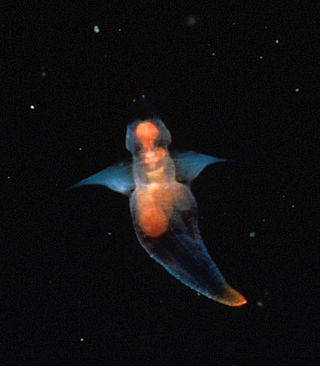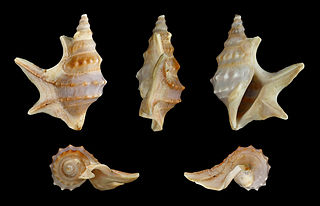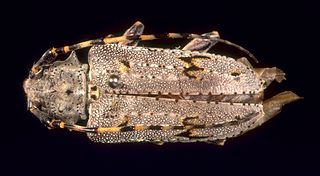
The International Code of Zoological Nomenclature (ICZN) is a widely accepted convention in zoology that rules the formal scientific naming of organisms treated as animals. It is also informally known as the ICZN Code, for its publisher, the International Commission on Zoological Nomenclature. The rules principally regulate:

The Clionidae are a family of sea angels, which are a group of pelagic marine gastropods.
In zoological nomenclature, author citation is the process in which a person is credited with the creation of the scientific name of a previously unnamed taxon. When citing the author of the scientific name, one must fulfill the formal requirements listed under the International Code of Zoological Nomenclature. According to Article 51.1 of the Code, "The name of the author does not form part of the name of a taxon and its citation is optional, although customary and often advisable." However, recommendation 51A suggests, "The original author and date of a name should be cited at least once in each work dealing with the taxon denoted by that name. This is especially important and has a unique character between homonyms and in identifying species-group names which are not in their native combinations." For the sake of information retrieval, the author citation and year appended to the scientific name, e.g. genus-species-author-year, genus-author-year, family-author-year, etc., is often considered a "de-facto" unique identifier, although this usage may often be imperfect.
In zoological nomenclature, the valid name of a taxon is the correct scientific name for that taxon. The valid name must be used for that taxon, regardless of any other name that may currently be used for that taxon, or may previously have been used. A name can only be valid when it is an available name under the International Code of Zoological Nomenclature (ICZN); if a name is unavailable, then it cannot be considered either valid or invalid.
In biology, a homonym is a name for a taxon that is identical in spelling to another such name, that belongs to a different taxon.

A conserved name or nomen conservandum is a scientific name that has specific nomenclatural protection. That is, the name is retained, even though it violates one or more rules which would otherwise prevent it from being legitimate. Nomen conservandum is a Latin term, meaning "a name to be conserved". The terms are often used interchangeably, such as by the International Code of Nomenclature for Algae, Fungi, and Plants (ICN), while the International Code of Zoological Nomenclature favours the term "conserved name".

Trigonalidae is a family of parasitic wasps in the suborder Apocrita. They are the only living members of the superfamily Trigonaloidea. Trigonalidae are divided into 2 subfamilies; Orthogonalinae and Trigonalinae. These wasps are extremely rare, but surprisingly diverse, with over 90 species in 16 genera, and are known from all parts of the world. It is possibly the sister group to all Aculeata.
The Botanical and Zoological Codes of nomenclature treat the concept of synonymy differently.

Dioctophyme renale, commonly referred to as the giant kidney worm, is a parasitic nematode (roundworm) whose mature form is found in the kidneys of mammals. D. renale is distributed worldwide, but is less common in Africa and Oceania. It affects fish-eating mammals, particularly mink and dogs. Human infestation is rare, but results in kidney destruction, usually of one kidney and hence not fatal. A 2019 review listed a total of 37 known human cases of dioctophymiasis in 10 countries with the highest number (22) in China. Upon diagnosis through tissue sampling, the only treatment is surgical excision.

Aglae is a genus of euglossine bees, with the only described species Aglae caerulea. Like all orchid bees, it is restricted to the Neotropics. They are metallic blue. This species, like the genus Exaerete, is a nest parasite on free-living Euglossini. A. caerulea lays its eggs in the nests of Eulaema nigrita, and possibly other Eulaema species.

Aporrhais pespelecani, common name the "pelican's foot", is a species of sea snail, a marine gastropod mollusk in the family Aporrhaidae.
Tricholepisma is a genus of primitive insects belonging to the family Lepismatidae.
AnimalBase is a project brought to life in 2004 and is maintained by the University of Göttingen, Germany. The goal of the AnimalBase project is to digitize early zoological literature, provide copyright-free open access to zoological works, and provide manually verified lists of names of zoological genera and species as a free resource for the public. AnimalBase contributed to opening up the classical taxonomic literature, which is considered as useful because access to early literature can be difficult for researchers who need the old sources for their taxonomic research.
In zoological nomenclature, emendations are intentional alterations made to the spelling of taxon names. In bacteriological nomenclature, emendations are made to the circumscription of a taxon.

Aegomorphus morrisi is a species of beetle in the family Cerambycidae. It was described by Uhler in 1855. The species name is often misspelled as morrisii (e.g.) but this spelling is not in prevailing usage and the original spelling is therefore valid under ICZN Article 33.4.

Aristobia voeti is a species of beetle in the family Cerambycidae. It was described by James Thomson in 1878. Although the name was originally spelled as "voetii", this spelling was not in use between 1894 and 2014, and therefore the spelling "voeti" must be preserved under ICZN Article 33.3.1, as this is the spelling that is in prevailing usage. It is known from Laos, China and Myanmar.

Porrostoma rhipidius is a species of net-winged beetle in the family Lycidae, found widely in Australia. The name is sometimes misspelled as "rhipidium" but under ICZN Article 31 species names that are nouns, such as rhipidius, must retain their original spelling regardless of generic placement.
Spintharus rallorum is a species of comb-footed spider in the family Theridiidae. It is found in Puerto Rico and Saint Kitts and Nevis. It is one of 15 new species described in 2018. The authors spelt the name as Spintharus ralli, but noted that it honoured the "grandparents of the first author of the species." As the name refers to more than one person, the World Spider Catalog changed it from the Latin genitive singular to the genitive plural.
Dioctophymidae is a family of nematodes belonging to the order Ascaridida. Much older literature uses the alternative spelling "Dioctophymatidae" but this alternative spelling was suppressed by the ICZN in a 1987 ruling.

Coleopsis is an extinct genus of stem-group beetles. It contains a single species, Coleopsis archaica, and is the only member of the family Coleopsidae. It is known from a single specimen from the Early Permian (Asselian) Meisenheim Formation of western Germany, estimated to be about 297 million years old. It is currently the oldest known beetle.











